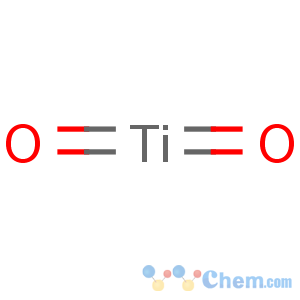Title: Titanium Dioxide
CAS Registry Number: 13463-67-7
CAS Name: Titanium oxide (TiO2)
Synonyms: unitane; C.I. Pigment White 6; C.I. 77891
Molecular Formula: O2Ti
Molecular Weight: 79.87
Percent Composition: O 40.06%, Ti 59.93%
Line Formula: TiO2
Literature References: Found in nature as the minerals
rutile (tetragonal),
anatase or
octahedrite (tetragonal),
brookite (orthorhombic),
ilmenite (FeTiO3), and
perovskite (CaTiO3). May be prepd by direct combination of titanium and oxygen; by treatment of titanium salts in aq soln; by the reaction of volatile, inorganic titanium compds with oxygen; by oxidation or hydrolysis of organic compds of titanium. Industrial prepn from ilmenite or rutile:
Faith, Keyes & Clark's Industrial Chemicals, F. A. Lowenheim, M. K. Moran, Eds. (Wiley-Interscience, New York, 4th ed., 1975) pp 814-821. Prepn of synthetic rutile: Merker,
US 2760874 (1956 to National Lead). Prepn of spectroscopically pure material by dissolving titanium in an ammoniacal soln of 90% H2O2: Czanderna
et al., J. Am. Chem. Soc. 79, 5407 (1957). Comprehensive description: H. G. Brittain
et al., Anal. Profiles Drug Subs. Excip. 21, 659-691 (1992).
Properties: White powder, mp 1855°. d (rutile): 4.23; (anatase): 3.90; (brookite): 4.13. Insol in water, HCl, HNO3, or dil H2SO4. Sol in hot concd H2SO4, in HF. The reactivity depends on a previous heat treatment; prolonged heating produces a less sol material. Also made sol by fusion with potassium bisulfate or with alkali hydroxides or carbonates to form alkali titanates. Possesses perhaps the greatest hiding power of all inorganic white pigments.
Titania is a name applied to large TiO2 crystals (translucent water-white or with yellowish cast) suitable for use in jewelry. These crystals have a refractive index (2.7) higher than diamonds (2.4), but lack the hardness of diamonds. When substantially pure, a massive single crystal (boule) of rutile has the properties of a precious gem with a very light straw color and with reflectance, refraction and brilliance measuring greater than those of a diamond.
Melting point: mp 1855°
Density: d (rutile): 4.23; (anatase): 3.90; (brookite): 4.13
NOTE: The rutile structure is common among metal fluorides and oxides of the type MF2 and MO2.
CAUTION: Potential symptom of overexposure is lung fibrosis. Potential occupational carcinogen.
See NIOSH Pocket Guide to Chemical Hazards (DHHS/NIOSH 97-140, 1997) p 310.
Use: Airfloated ilmenite is used for titanium pigment manuf. Rutile sand is suitable for welding-rod-coating materials, as ceramic colorant, as source of titanium metal. As color in the food industry. Anatase titanium dioxide is used for welding-rod-coatings, acid resistant vitreous enamels, in specification paints, exterior white house paints, acetate rayon, white interior air-dry and baked enamels and lacquers, inks and plastics, for paper filling and coating, in water paints, tanners' leather finishes, shoe whiteners, and ceramics. High opacity and tinting values are claimed for rutile-like pigments.
Therap-Cat: Protectant (topical); ultraviolet sunscreen.
Keywords: Topical Protectant.

